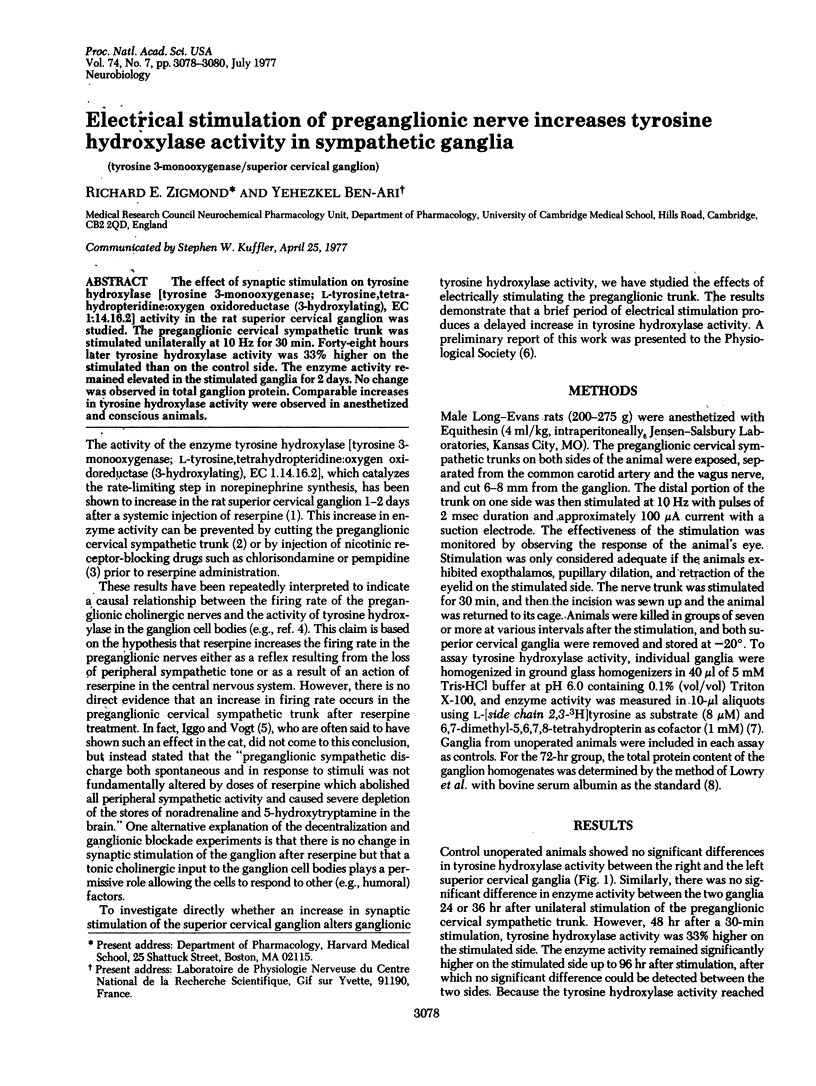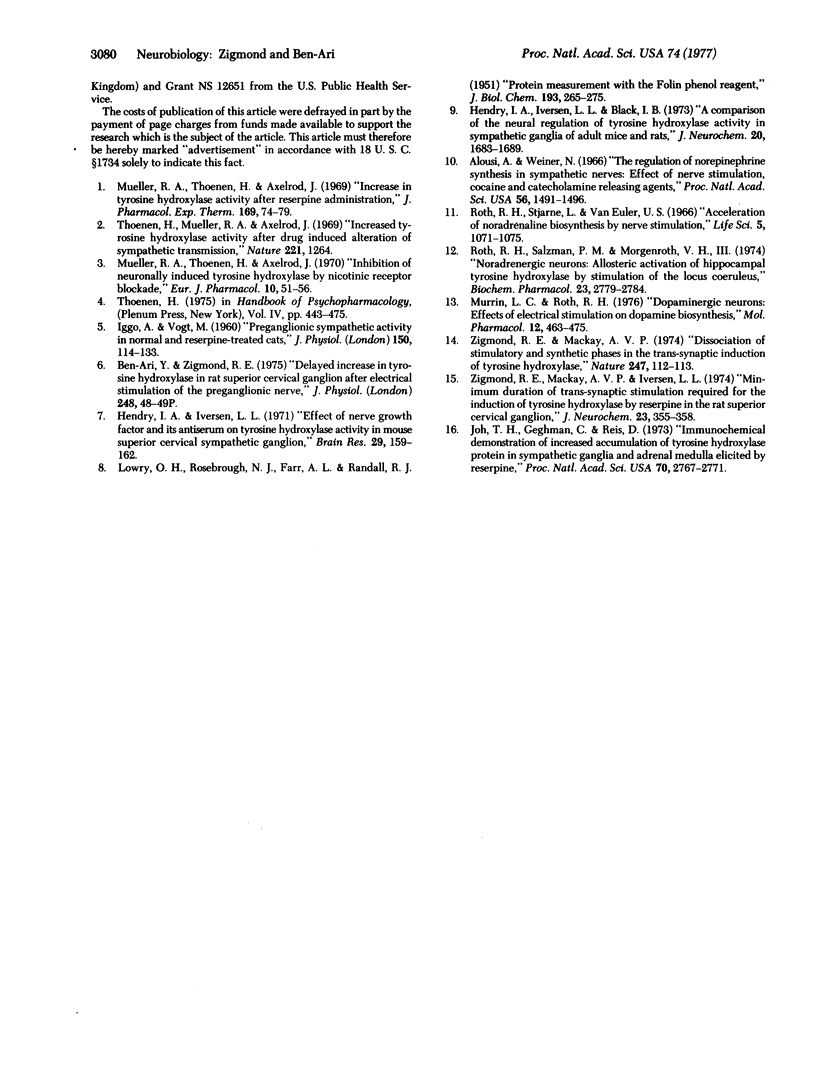Abstract
The effect of synaptic stimulation on tyrosine hydroxylase [tyrosine 3-monooxygenase: L-tyrosine, tetrahydropteridine:oxygen oxidoreductase (3-hydroxylating), EC 1.14.16.2] activity in the rat superior cervical ganglion was studied. The preganglionic cervical sympathetic trunk was stimulated unilaterally at 10 Hz for 30 min. Forty-eight hours later tyrosine hydroxylase activity was 33% higher on the stimulated than on the control side. The enzyme activity restimulated than on the control side. The enzyme activity remained elevated in the stimulated ganglia for 2 days. No change was observed in total ganglion protein. Comparable increases in tyrosine hydroxylase activity were observed in anesthetized and conscious animals.
Full text
PDF


Selected References
These references are in PubMed. This may not be the complete list of references from this article.
- Alousi A., Weiner N. The regulation of norepinephrine synthesis in sympathetic nerves: effect of nerve stimulation, cocaine, and catecholamine-releasing agents. Proc Natl Acad Sci U S A. 1966 Nov;56(5):1491–1496. doi: 10.1073/pnas.56.5.1491. [DOI] [PMC free article] [PubMed] [Google Scholar]
- Ben-Ari Y., Zigmond R. E. Proceedings: Delayed increase in tyrosine hydroxylase activity in rat superior cervical ganglion after electrical stimulation of the preganglionic nerve. J Physiol. 1975 Jun;248(1):48P–49P. [PubMed] [Google Scholar]
- Hendry I. A., Iversen L. L., Black I. B. A comparison of the neural regulation of tyrosine hydroxylase activity in sympathetic ganglia of adult mice and rats. J Neurochem. 1973 Jun;20(6):1683–1689. doi: 10.1111/j.1471-4159.1973.tb00284.x. [DOI] [PubMed] [Google Scholar]
- Hendry I. A., Iversen L. L. Effect of nerve growth factor and its antiserum on tyrosine hydroxylase activity in mouse superior cervical sympathetic ganglion. Brain Res. 1971 Jun 4;29(1):159–162. doi: 10.1016/0006-8993(71)90429-x. [DOI] [PubMed] [Google Scholar]
- IGGO A., VOGT M. Preganglionic sympathetic activity in normal and in reserpine-treated cats. J Physiol. 1960 Jan;150:114–133. doi: 10.1113/jphysiol.1960.sp006377. [DOI] [PMC free article] [PubMed] [Google Scholar]
- Joh T. H., Geghman C., Reis D. Immunochemical demonstration of increased accumulation of tyrosine hydroxylase protein in sympathetic ganglia and adrenal medulla elicited by reserpine. Proc Natl Acad Sci U S A. 1973 Oct;70(10):2767–2771. doi: 10.1073/pnas.70.10.2767. [DOI] [PMC free article] [PubMed] [Google Scholar]
- LOWRY O. H., ROSEBROUGH N. J., FARR A. L., RANDALL R. J. Protein measurement with the Folin phenol reagent. J Biol Chem. 1951 Nov;193(1):265–275. [PubMed] [Google Scholar]
- Mueller R. A., Thoenen H., Axelrod J. Increase in tyrosine hydroxylase activity after reserpine administration. J Pharmacol Exp Ther. 1969 Sep;169(1):74–79. [PubMed] [Google Scholar]
- Mueller R. A., Thoenen H., Axelrod J. Inhiition of neuronally induced tyrosine hydroxylase by nitinic receptor blockade. Eur J Pharmacol. 1970 Apr;10(1):51–56. doi: 10.1016/0014-2999(70)90156-1. [DOI] [PubMed] [Google Scholar]
- Murrin L. C., Roth R. H. Dopaminergic neurons: effects of electrical stimulation on dopamine biosynthesis. Mol Pharmacol. 1976 May;12(3):463–475. [PubMed] [Google Scholar]
- Roth R. H., Salzman P. M., Morgenroth V. H., 3rd Noradrenergic neurons: allosteric activation of hippocampal tyrosine hydroxylase by stimulation of the locus coeruleus. Biochem Pharmacol. 1974 Oct 1;23(19):2779–2784. doi: 10.1016/0006-2952(74)90051-3. [DOI] [PubMed] [Google Scholar]
- Roth R. H., Stjärne L., von Euler U. S. Acceleration of noradrenaline biosynthesis by nerve stimulation. Life Sci. 1966 Jun;5(12):1071–1075. doi: 10.1016/0024-3205(66)90089-0. [DOI] [PubMed] [Google Scholar]
- Thoenen H., Mueller R. A., Axelrod J. Increased tyrosine hydroxylase activity after drug-induced alteration of sympathetic transmission. Nature. 1969 Mar 29;221(5187):1264–1264. doi: 10.1038/2211264a0. [DOI] [PubMed] [Google Scholar]
- Zigmond R. E., Mackay A. V. Dissociation of stimulatory and synthetic phases in the induction of tyrosine hydroxylase. Nature. 1974 Jan 11;247(5436):112–113. doi: 10.1038/247112a0. [DOI] [PubMed] [Google Scholar]
- Zigmond R. E., Mackay A. V., Iversen L. L. Minimum duration of trans-synaptic stimulation required for the induction of tyrosine hydroxylase by reserpine in the rat superior cervical ganglion. J Neurochem. 1974 Aug;23(2):355–358. doi: 10.1111/j.1471-4159.1974.tb04365.x. [DOI] [PubMed] [Google Scholar]


